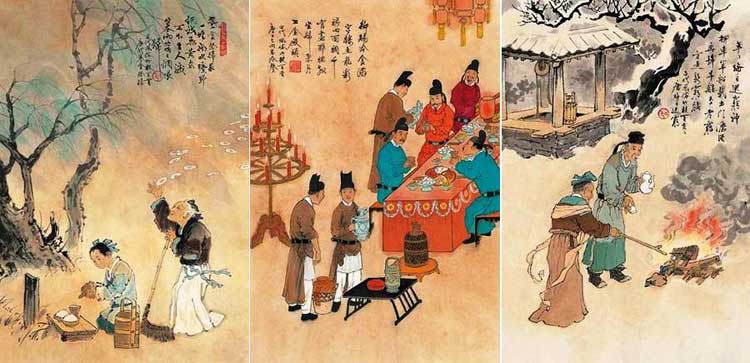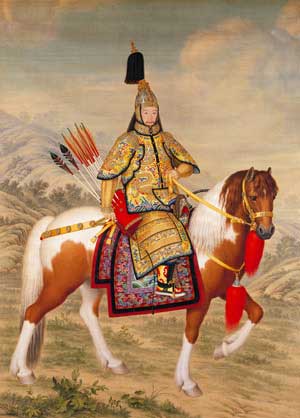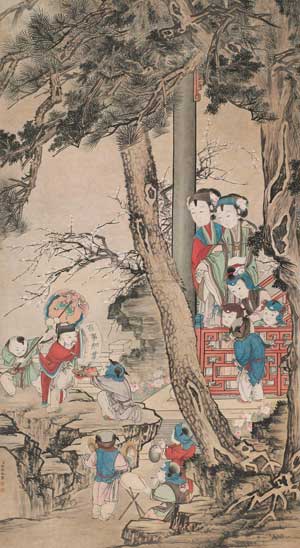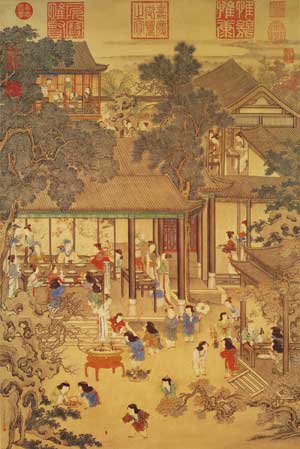Written by: Yan Ziyun
Posted on: January 26, 2017 |  | 中文
| 中文
'Peaceful Spring Market' - Ding Guanpeng (source - Chinese Portal)
The Spring Festival, also known as "Turnover of the Year", "Chinese New Year", “The Day of the Very Beginning” or “The Beginning of the Year", is the most formally celebrated traditional festival of the Chinese people. It gets a top ranking among all traditional festivals in China in terms of grandeur and festivity.
The Spring Festival has a history of more than 4,000 years. Over the centuries, it has developed into a colorful annual celebration in China, as described in literature and painting works. In this issue, we will delve into the ancient customs of the festival by exploring some ancient Chinese paintings.
Li Song (Southern Song Dynasty 1127-1279 AD)
This typical festival painting depicts the folk customs of the Spring Festival. Li Song was good at expressing his feelings and attitude towards life in his paintings. Watching lanterns is the theme of entertainment activities at the Lantern Festival, which originated in the Han Dynasty, was developed in the Sui Dynasty and witnessed its rise in the Song dynasty. The Lantern Festival in Song Dynasty was the most bustling, enjoyable and romantic holiday, as it was cherished and expressed by many poets of the time with strong emotion.

Anonymous painter (Ming Dynasty 1368-1644 AD)
This painting was painted on a piece of tough silk, 37 cm wide and 624 cm long, depicting Zhu Jianshen, Emperor Xianzong of Ming Dynasty, enjoying a lantern show and performance in his royal garden. A grand scene was presented with rigorous composition and fine brushwork. Viewing the long painting, one can see clearly the vivid images of magnificent palaces, courtyards, the emperor, many beauties in costumes and other people. It looks complex with so many figures, but all of them are well-proportioned rather than chaotic.
The performance depicted in the painting is also brilliant, including comedians’ miscellaneous play, juggling, street vendors, lanterns and firecrackers; and some images of archery, kicking Ju, polo, Chui-Wan, Touhu and a series of games; even houses of ordinary people downtown were recreated to act as markets and streets, showing a stream of wandering citizens.
Painter anonymous (Ming Dynasty)
This painting, 2 meters long and 0.26 meters high, depicts a spectacular scene of the Lantern Festival in front of a Confucius Temple in Nanjing during the Ming Dynasty. It focuses on the life of the literati in front of the gate of Confucius temple, which was an antique market since ancient times. The picture mainly concentrates on the life of Chinese literati, which includes a gallery and storytellers. It shows that these intellectuals have started to plant daffodils, buy rockery, pebbles (colorful fine-grained pebbles found in Yuhuatai Area in Nanjing), and keep goldfish, plum, or orchid.
by Ding Guanpeng (Qing Dynasty)
This is a roll of painting that describes a lively celebration of the Lantern Festival in rural areas, including the scene of fireworks, Taiping Drums, fruits on sale, a monkey trick show, and an artists’ performance. It can be seen in the painting that some literati under pine trees are enjoying their tea while chatting, and some bowls with which porters hold desserts are decorated with blue and white dragons, which were typical during the time of Emperor Qianlong of the Qing.
by Giuseppe Castiglione (Lang Shi-ning, 1688-1766, Qing Dynasty)

Giuseppe Castiglione (Chinese name ‘Lang Shi-ning’) was an Italian missionary and painter who came to Qing China in 1715 and served the Qing Court for more than 50 years. These series of paintings show the daily life of Emperor Yong Zheng (the fifth emperor of Qing Dynasty). The paintings reflect the images and events of the emperor in the sequence of 12 lunar months from spring to winter, displaying various scenes of Royal life in the Old Summer Palace, as well as different customs in various festivals. They mainly depict landscape and pavilions, including delicate images of Chinese gardening, Western pavilions and terraces.
by Tang Dai, Ding Guanpeng (Qing Dynasty)
This painting shows a carnival on the Lantern Festival night. In the painting we find that all the places are decorated with lanterns and crowded with some people lighting fireworks, and others drinking and enjoying the beauty of the lanterns; children are also seen playing under the frame of the lanterns. The whole painting vividly displays the festive scenes of the time.
by Giuseppe Castiglione (Lang Shi-ning), Shen Yuan, Zhou Kun and Ding Guanpeng (Qing Dynasty)

This painting was co-painted by Giuseppe Castiglione and three Chinese painters of the Qing time. Giuseppe Castiglione (Lang Shi-ning), who was good at painting portraits, painted Emperor Qianlong. Three Chinese painters painted the children (of the Qing Royal Family), houses and trees. This painting is a successful blend of artistic work combining Chinese and western painting skills, under the emperor’s power, not only displaying the Royal life on a festive and peaceful New Year’s day, but also showing the warm family relations between Emperor Qian Long and his princes.
by Xu Yang (Qing Dynasty)
Xu Yang was skilled at painting portraits, landscape, plants, birds, and insects. Learning from the famous Song Dynasty painting "Riverside Scene on Qingming Festival", he applied the skill of scattering perspective to paint the city’s landscape in a realistic way. His historical works include "Emperor Qianlong Inspecting the South" and "Coming of the Flourishing Age”. His other works which exist today are "Beijing Spring Poetic Scenes" and "Wang Xizhi Copying Trading the Sutra for Geese", etc.
by Leng Mu (Qing Dynasty)
This painting depicts the Spring Festival celebration scene of a big family in the courtyard. There are various figures in the painting, and the most important one is an official sitting in a chair surrounded by some women, children and servants. What is interesting is that the painter focuses on portraying the manners and expressions of the figures celebrating the Spring Festival with elegant colors.
by Yao Wenhan (Qing Dynasty)

The painting depicts a scene of a family reunion to celebrate the Spring Festival. The host is seen sitting in the living room while his children are playing gongs, drums, clappers, and Sheng (a reed pipe wind instrument), and setting off firecrackers. There are also some servants standing aside, holding a wine kettle, or fetching dim sum or fruits between the hall and cloisters. In the middle of the hall, there is a brazier with pine tree branches and sesame straw burning in it. A four-season flower screen stands indoors, and on the red tea table stands a vase painted with images of peonies. All this depicts an atmosphere of a wealthy and noble family enjoying the festival.
by Zhao Zhichen, Guzou (Qing Dynasty)
This painting shows children playing gongs and drums to celebrate the Lantern Festival, depicting the typical folk customs of the festival in the Qing time.
You may also like: